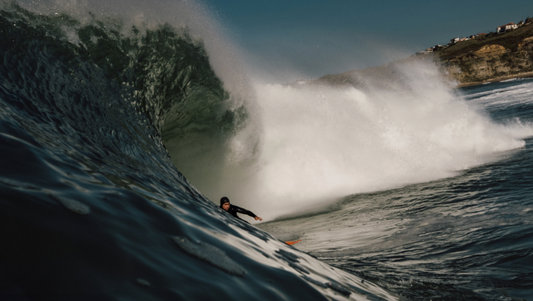“It's basically a natural Styrofoam with a tremendous amount of tensile strength, vertically,” says Craig Reynolds, President and Founding Director of the California Agave Council. A strong and natural Styrofoam? For surfboard makers, that’s like a dream come true. And from fibrous sisal rope to biofuel to food and dozens of other products — there’s certainly a lot of uses for the agave plant. But as we’d come to find, in a recent conversation with Craig, the plant is even resistant to…climate change? In comparison to most other crops in California: Yes. For a deeper dive into agave’s historical, environmental, and economical merits, Craig tapped us into the fascinating story.
Agave Brothers Ranch: Talk to us about your relationship with agave…
Craig Reynolds: I've been growing agave for almost 20 years now since I first planted agave in Colima, Mexico. That led to producing an agave spirit that I imported and distributed in the United States called Dos Volcanes, like volcano, because it was grown at the base of the two Colima volcanoes. I've always been intrigued by the plant. It's a beautiful plant. It has so many wonderful properties, and it can be used for so many things. It has a great history that even preceded agave spirits, too. Like, it was a source of food for the various native people in Mexico who cooked the agave in pits to make it sweet, edible, and nutritious. It was a major staple of the pre-Hispanic, Mesoamerican diet.
But it also has uses for its fiber. That was one of the historical uses when the colonialists, the Spaniards, came to Mexico. One of their top — and, I've heard second-most — exported products to Europe was sisal, which is Agave sisalana, or Henequen, which was grown in the Yucatan. They used it for the ropes for cargo ships all over the world. That was in the 16th century. Even today, agave fiber, or sisal rope, is the most durable marine rope you can get. It withstands sun and saltwater, whereas their modern polypropylene substitutes degrade. But what's remarkable about agave is its incredible tensile strength. If you take care of agave fiber, it's really hard for just a single strand to rip apart.
Didn’t know that!
Yeah, agave americana, which are the large, "century plants" here in California that are pretty much endemic throughout the state, produce very large quiotes, or stalks. Those can produce blanks for surfboards, and people have been doing that for many years, but on a pretty small, boutique scale. Harvesting a few of those is difficult. You can also use Agave tequilana, but they're smaller, so you don't get as much lumber, if you will. When you look at agave surfboards, though they're just beautiful when you put a clear fiberglass coating on them. The wood grain comes through, and there's no need to color them. It's a beautiful, fairly light surfboard. It's basically a natural Styrofoam with a tremendous amount of tensile strength, vertically.
Agreed. Are there other uses for agave as well?
Oh, yeah, agave is also useful for its syrup. Its highest value is for spirits, of course. But as I mentioned, it can be used for food, and also biomass fuel. That’s in the early stages and no one's doing it at scale now, but they've been doing a number of field experiments using agave waste to produce fuel, as you would corn or sugarcane. When you take the full climate carbon analysis, it's actually a better solution, and you're not replacing a food crop. You can grow agave with virtually no irrigation, whereas those other biofuels require a lot more cost inputs and water. That’s a serious issue due to climate change in most agricultural environments.
I didn’t know they needed so little water to grow.
Yeah, it’s pretty incredible. The real question is: what are you going to do with the waste? The heart of the agave has the most potential fermentable sugar, or sugar carbohydrate, used for food or spirits production. The pencas, or leaves, also represent about 30% of the total biomass and carbon. That has potential for biofuel, but also for animal feed and returning that carbon back into the soil. People can make a fine silk out of the agave fibers in Northern Africa.
What are some of the economic benefits coming from agave that have you observed?
I'm the founding director and president of the California Agave Council, which has just been growing exponentially. In the two and a half years since we formed, we have maybe 80 growers across 32 counties and a dozen craft distillers. The economics from the perspective of a farmer are fantastic because it's a climate resilient, adaptive crop alternative that can deal with this changing climate and severe water restrictions in California. Those restrictions are the result of climate change, over drafting of groundwater, cutbacks, regulations limiting pumping of groundwater, as well as delivery from the state water projects to growers. So, without an alternative crop to replace these highly water-consumptive crops like almonds, pistachios, tomatoes, and avocados, farmers are left with few alternatives. They are having to fallow thousands of acres in California, and are predicted to potentially have to fallow as much as 800,000 acres in the next 15 to 20 years. That's already happening. So, the economics of having a crop that’s in its infancy and in high demand is that growers can get more income per acre growing agave than they can pretty much anything else. It rivals even high-end Cabernet wine grapes.
Just for perspective, a typical almond orchard in California requires four acre-feet a year, which is 48 inches covering an acre of water for a year. Agave will take maybe three inches using drip irrigation over the summer. So, it's a huge water savings. It can even survive a complete drought once established, with no water at all. It’s a very resilient crop.
I’ll say. So, you primarily just deal with agave around here, not in Kenya where a lot of surfboard blanks made from agave are coming from?
Correct. In Kenya, they're growing for sisal, which is a tall, fibrous plant. I don't know if anyone's tried making spirits out of that — I'm sure they have — but it's not optimum for that. It's optimum for its fiber. Agave tequilana, produces fiber as well, but it's not optimum for fiber. It's optimum for high sugar content in the heart.
Are you involved with surfboard makers shaping with agave much?
Not a whole lot, but I've been in contact with them for a few years now, and they're associate members of our council. So, we're promoting agave. Our association is primarily agave growers and agave distillers but also other processors of California agave. We have common interests. We’d definitely like to help them in their marketing because we want them to be successful. We would love it if someone were to use what limited agave flower stalks we have here to make California-grown surfboards. There's no reason not to, they're just going to be more expensive.
Awesome. Ultimately, what would you love to see happen with this plant?
I just think it's a great plant with multiple uses, with a number of varieties that are actually native to California. I think when people see that it can be more than ornamental — and it certainly has value there — as people are ripping out their lawns, they can use it for low-water-use landscaping. Anything that turns people on to agave, I'm all for.




